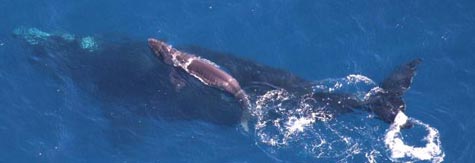Scientists watch whale’s birth near Navy training range
Scientists surveying the area near a planned Navy training range said Tuesday they witnessed an endangered right whale giving birth off the Northeast Florida coast. It was only the second time a right whale’s birth has been seen and studied, and it gave researchers new insights into the lives of some of the world’s most endangered mammals. It also gave hope to environmental groups that sued to stop the Navy’s plans.
Amazed researchers in a small plane lingered for nearly a half-hour Saturday as a whale that scientists knew as Derecha churned the ocean surface east of Vilano Beach and dove underwater, replaced at the surface minutes later by her newborn.
The discovery was made within several miles of the rectangular patch of sea the Navy selected last year for construction of an undersea warfare range. The exact distance wasn’t clear, but appeared to be somewhere near 10 miles.
“It was near the box … [but] drawing a line in the ocean is a difficult thing,” said William McLellan, a University of North Carolina-Wilmington research associate overseeing Navy-financed survey work done with Duke University.
The Florida-Georgia coast is the only known calving ground for right whales, which gather each winter after traveling from New England and Canada.
From a total population of about 450, more than 100 whales migrated to the area this winter.
Environmental advocates, who have warned that ship traffic and sonar use at the training range could imperil the whales, said the discovery reinforces their concerns.
“The Navy needs to go back to square one and reconsider,” said Sharon Young, marine issues field director for the Humane Society of the United States. The group is one of several that sued in January to challenge the training range plans.
“This birth, which is just the most amazing thing, ought to give us pause,” said Young, a former marine scientist.

